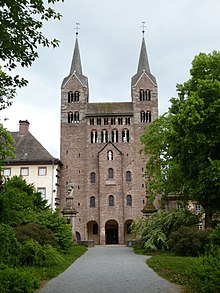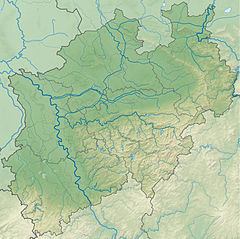
Back Абатство Корвей Bulgarian Abadia de Corvey Catalan Klášter Corvey Czech Corvey Danish Stift Corvey German Corvey Esperanto Abadía de Corvey Spanish Corveyko abadia Basque کلیسای شاهی کروی Persian Corveyn luostari Finnish
| Abbey church of Corvey | |
|---|---|
 The Westwork of Corvey Abbey | |
| Religion | |
| Affiliation | Catholic |
| Year consecrated | 844 |
| Location | |
| Municipality | Höxter |
| State | North Rhine-Westphalia |
| Geographic coordinates | 51°46′44″N 9°24′34″E / 51.77885°N 9.40943°E |
| Architecture | |
| Style | Carolingian, High Romanesque, Baroque |
| Official name: Carolingian Westwork and Civitas Corvey | |
| Type | Cultural |
| Criteria | ii, iii, iv |
| Designated | 2014 (38th session) |
| Reference no. | 1447 |
| State Party | Germany |
| Region | Europe and North America |
| Property | 12 ha (30 acres) |
| Buffer zone | 69 ha (170 acres) |

The Princely Abbey of Corvey (German: Fürststift Corvey or German: Fürstabtei Corvey) is a former Benedictine abbey and ecclesiastical principality now in North Rhine-Westphalia, Germany. It was one of the half-dozen self-ruling princely abbeys of the Holy Roman Empire from the Late Middle Ages until 1792 when Corvey was elevated to a prince-bishopric. Corvey, whose territory extended over a vast area, was in turn secularized in 1803 in the course of the German mediatisation and absorbed into the newly created Principality of Nassau-Orange-Fulda. Originally built in 822 and 885 and remodeled in the Baroque period, the abbey is an exceptional example of Carolingian architecture, the oldest surviving example of a westwork, and the oldest standing medieval structure in Westphalia.[1] The original architecture of the abbey, with its vaulted hall and galleries encircling the main room, heavily influenced later western Romanesque and Gothic architecture. The inside of the westwork contains the only known wall paintings of ancient mythology with Christian interpretation in Carolingian times.[1] The former abbey church was listed as a UNESCO World Heritage Site in 2014.[1]

- ^ a b c "Carolingian Westwork and Civitas Corvey". UNESCO World Heritage Centre. United Nations Educational, Scientific, and Cultural Organization. Retrieved 17 September 2022.


